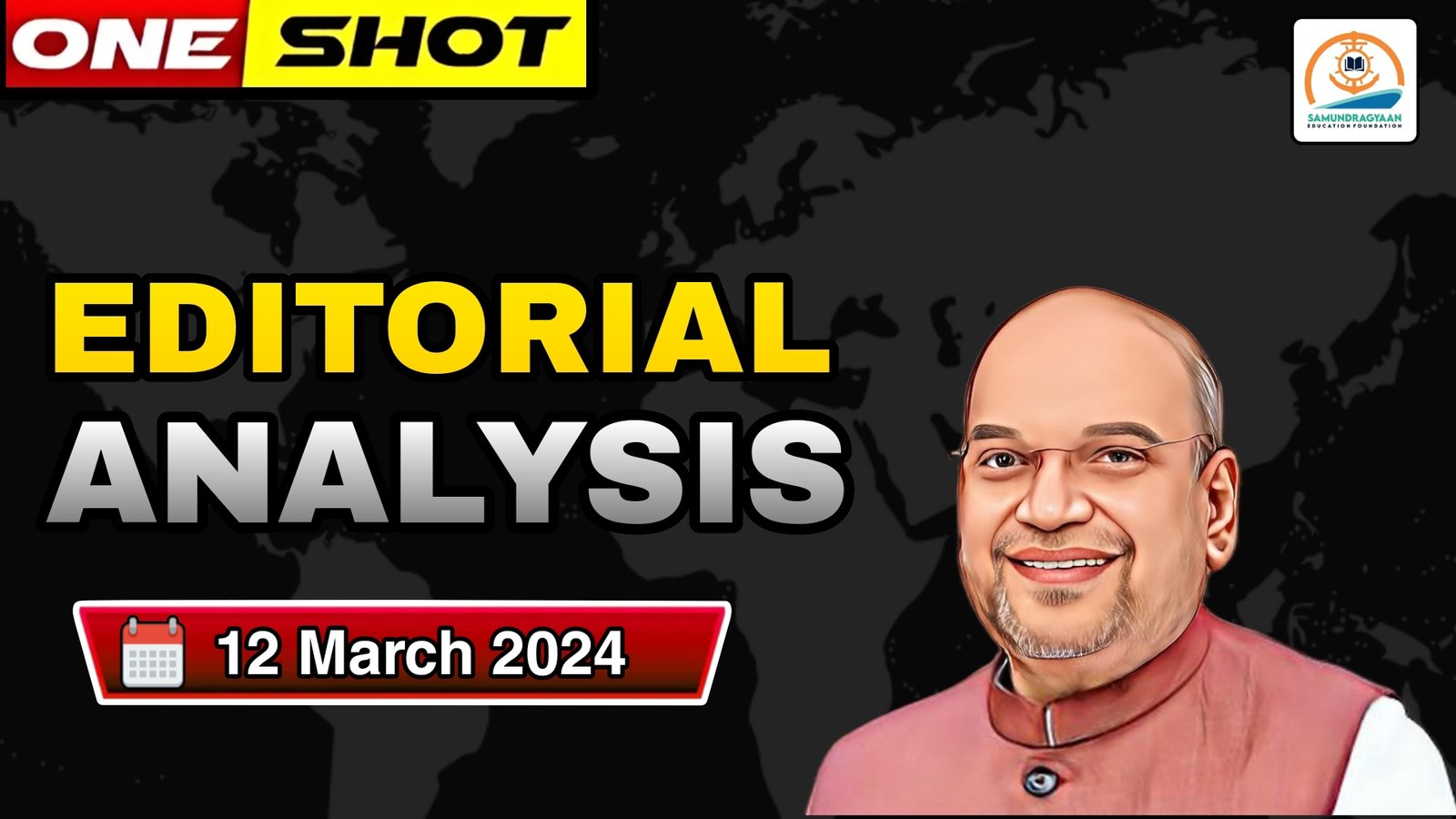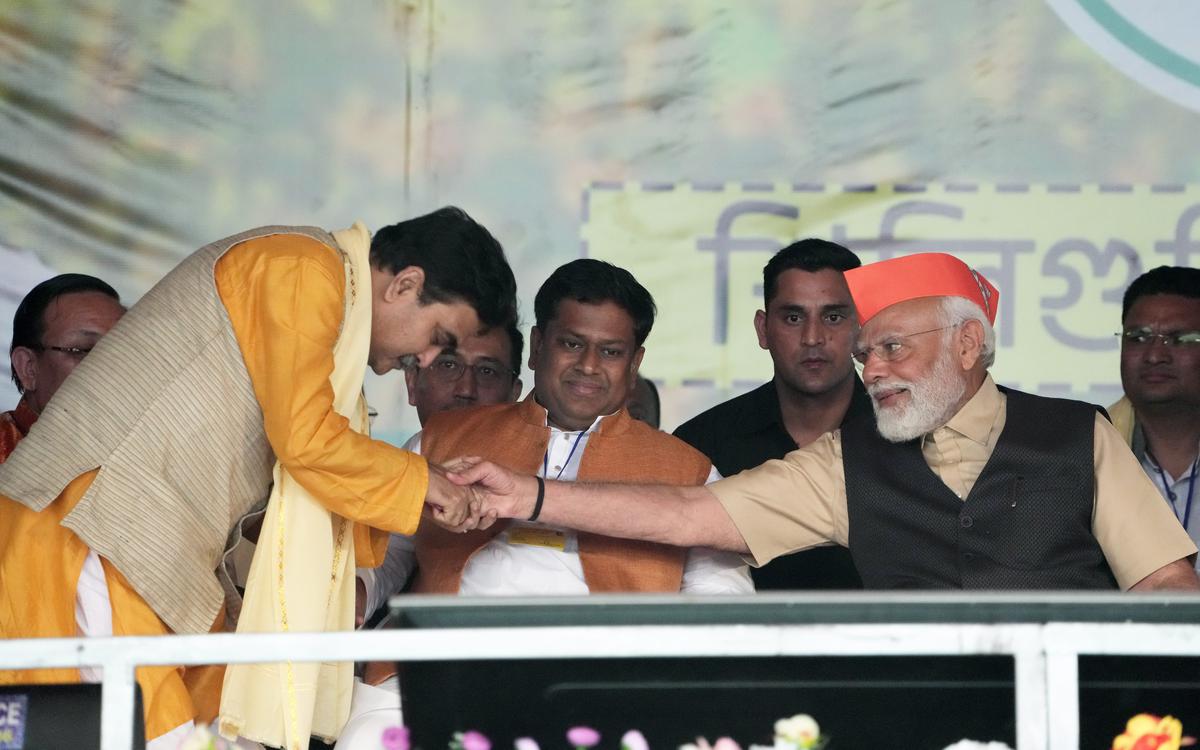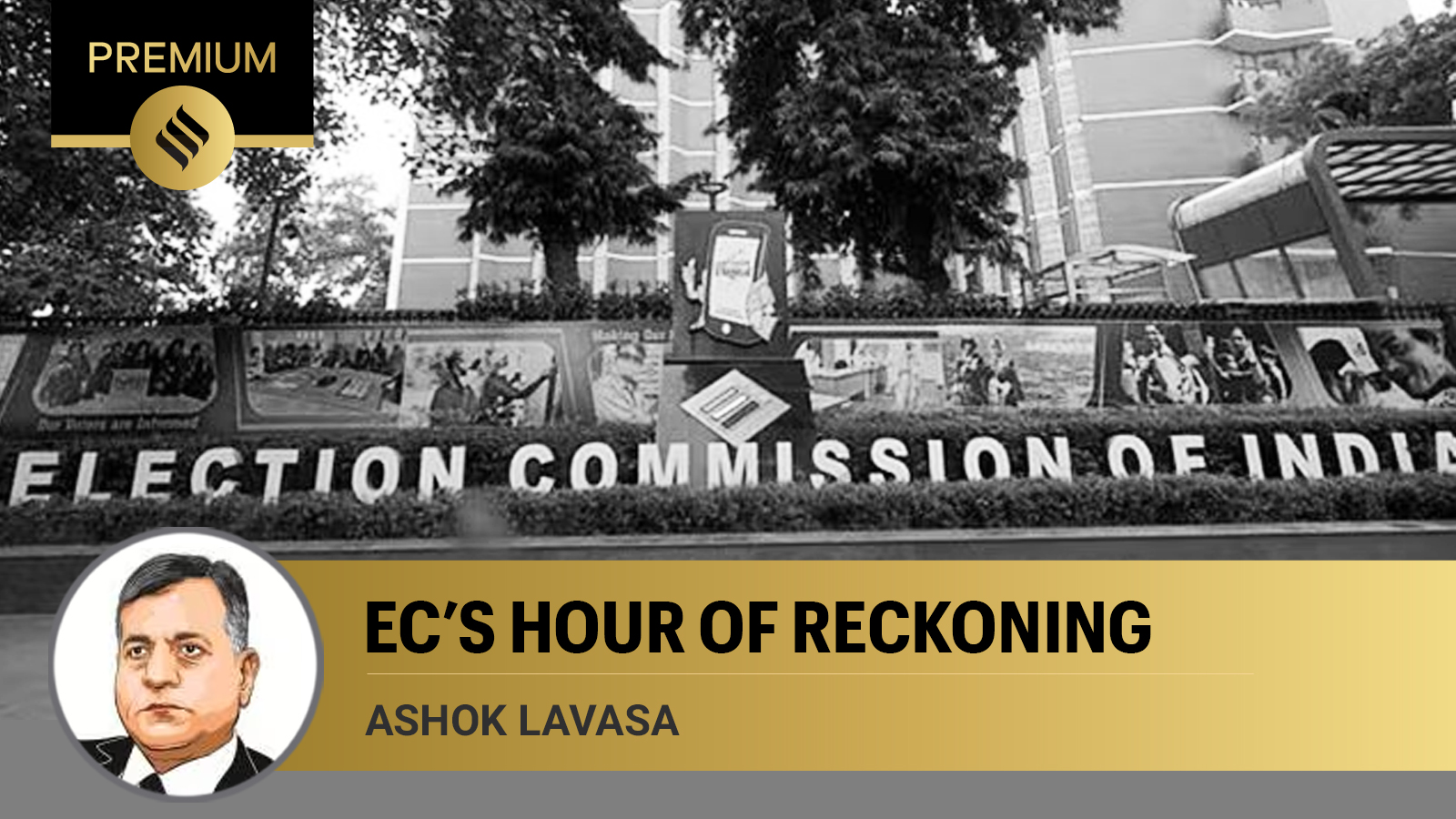Why in news?
- The Ministry of Home Affairs (MHA) has notified the Citizenship Amendment Rules, 2024 that would enable the implementation of the Citizenship Amendment Act (CAA).
- The Act was passed on December 11, 2019, receiving assent from the President on December 12 the same year.
- The MHA had earlier notified that the Act will come into force from January 10, 2020. Since the rules were not framed yet, the Act could not be implemented.
What’s in today’s article?
- Citizenship Amendment Act (CAA)
- Citizenship Amendment Rules, 2024
The Citizenship (Amendment) Act (CAA) 2019:
- About:
- It seeks to amend the definition of illegal immigrant for Hindu, Sikh, Parsi, Buddhist, Jains and Christian (but not Muslim) immigrants from Pakistan, Afghanistan and Bangladesh, who have lived in India without documentation.
- They will be granted fast track Indian citizenship in 5 years (11 years earlier).
- The Act (which amends the Citizenship Act 1955) also provides for cancellation of Overseas Citizen of India (OCI) registration where the OCI card-holder has violated any provision of the Citizenship Act or any other law in force.
- Who is eligible?
- The CAA 2019 applies to those who were forced or compelled to seek shelter in India due to persecution on the ground of religion. It aims to protect such people from proceedings of illegal migration.
- The cut-off date for citizenship is December 31, 2014, which means the applicant should have entered India on or before that date.
- The act will not apply to areas covered by the Constitution’s sixth schedule, which deals with autonomous tribal-dominated regions in Assam, Meghalaya, Tripura, and Mizoram.
- Additionally, the act will not apply to states that have an inner-line permit regime (Arunachal Pradesh, Nagaland and Mizoram).
- Delay in notification of CAA rules
- One of the prime reasons is the vociferous opposition faced by the CAA in several states including Assam and Tripura.
- The protests in Assam were fuelled by fears that the legislation would permanently alter the demographics of the state.
- CAA is seen in Assam as a violation of the 1985 Assam Accord which allows foreign migrants who came to Assam after January 1, 1966 but before March 25, 1971 to seek citizenship.
- Cut-off date for citizenship under the CAA is December 31, 2014.
- The protests didn’t remain confined to the North-East, but spread to other parts of the country.
- Multiple petitions are before the Supreme Court, challenging the constitutional validity of the CAA.
- The petitioners have contended that the law is anti-Muslim, violating Article 14 (Right to Equality) of the Indian Constitution.
- It is arbitrary as it leaves out the persecuted Rohingya of Myanmar, Tibetan Buddhists from China and Tamils from Sri Lanka.
Citizenship Amendment Rules, 2024
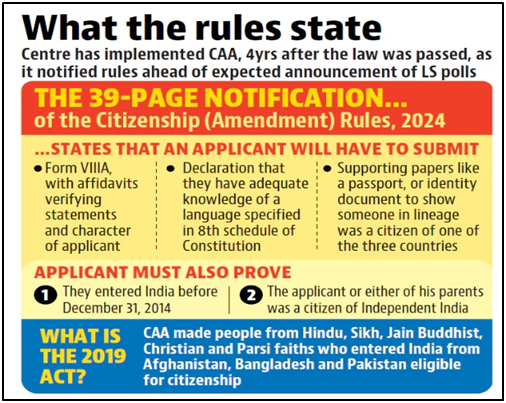
- The process
- Eligible refugees seeking citizenship through registration or naturalization must submit an application along with an affidavit confirming the accuracy of the statements made in it.
- Additionally, they need an affidavit from an Indian citizen vouching for their character and a declaration stating their familiarity with one of the languages listed in the eighth schedule to the Constitution of India.
- E-application to the district-level committee
- The rules require the application to be submitted electronically to an empowered committee via the district-level committee, as notified by the central government.
- Once the application is submitted, the district-level committee, headed by a designated officer, will verify the documents.
- It will also administer the oath of allegiance to the applicant.
- If an applicant doesn’t show up in person to sign the application and take the oath of allegiance, despite being given chances, the district-level committee will send the application to the empowered committee to consider rejecting it.
- Supporting documents
- Applicants must provide supporting documents such as:
- passport issued by the governments of Pakistan, Afghanistan, or Bangladesh,
- a birth certificate,
- any form of identity document, land or tenancy records, or
- any document proving that the applicant’s parents, grandparents, or great-grandparents were citizens of one of the three countries.
- These documents remain valid even beyond their expiration dates.
- Until now, these migrants were either living in India illegally or on long-term visas.
- Verification of entry date
- Applicants also have to provide proof that they entered India before December 31, 2014.
- 20 supporting document for this can be of:
- either a visa and immigration stamp, registration certificate from the Foreigners Regional Registration Officer (FRRO),
- or slip issued by the Census enumerators in India, government-issued licence or certificate
- permit in India (including driving license, Aadhaar number, ration card),
- marriage certificate issued in India etc.
- Digital certificate
- Once an application is approved, the applicants will be issued a digital certificate.
New rule has changed the producers to grant citizenship
- Earlier, citizenship applications were made to the district collector, who is under the administrative control of the state government.
- The new rules provide for an empowered committee and a district level committee to be instituted by the Centre for receiving and processing the applications.
- These applications are to be submitted electronically.
- The empowered committee would be headed by a director (census operations).
- Other members include:
- deputy secretary or above officer of the Subsidiary Intelligence Bureau, the FRRO,
- state informatics officer of the National Informatics Centre,
- postmaster general of the state.
- There would also be two invitees to the committee:
- a representative from the office of principal secretary (home) or additional chief secretary (home) of the state government or UT concerned; and
- a representative of the Railways’ jurisdictional divisional railway manager.
Why did the SC Reject SBI’s Plea for More Time to Provide Details?

Why in News?
- The Supreme Court dismissed a plea by the State Bank of India (SBI) to extend the deadline for providing details of electoral bonds purchased anonymously and their encashment by political parties to June 30, 2024. A five-judge Bench (headed by the CJI) gave the bank 24 hours to provide the details to the Election Commission of India (ECI).
What’s in Today’s Article?
- Background of the Issue
- Why did SBI Seek more Time to Comply?
- What did the Contempt Plea Stipulate?
- What did the Top Court Say?
Background of the Issue:
- The petition was filed in the aftermath of the SC’s verdict striking down the electoral bonds scheme (EBS), where the Court had directed the SBI to furnish details of the bonds to the ECI by March 6, 2024.
- These details were to include the date of purchase of each bond, the name of the purchaser of the bond and the denomination of the bond purchased.
- The ECI was subsequently ordered to publish all such information shared by the SBI on its official website by March 13, 2024.
- The court was also hearing a contempt plea filed by NGOs (ADR and Common Cause) against the SBI Chairman.
- The plea contends that the bank was deliberately trying to ensure that details were not disclosed to the public before the Lok Sabha elections due in April-May.
- Analysis reveals that the BJP was the scheme’s greatest beneficiary.
Why did SBI Seek more Time to Comply?
- The bank said that the information and documents were scattered across its various branches and decoding them was a “time-consuming exercise.”
- The data related to the issuance of the bond and data related to the redemption of the bond were recorded “in two different silos.”
- This was done to ensure that donors’ anonymity was protected.
- The Court was also informed that donor information was kept in a sealed cover at the selected branches and thereafter deposited in the organisation’s main branch in Mumbai.
- It can thus be noted that both sets of information were being stored independently of each other.
- Thus, to re-match them would be a task requiring a significant amount of effort.
- The SBI added that –
- While some details such as the number of bonds issued are stored digitally,
- Others such as the names of the purchasers and KYC documentation are stored physically in its various branches to “achieve the object of the scheme.”
What did the Contempt Plea Stipulate?
- All electoral bond-related work was overseen by a specific team of the SBI called the Transaction Banking Unit (TBU) to ensure that the government can access crucial information on a short notice.
- The petitioners claimed that the SBI maintains a secret number-based record of donors who buy bonds and the political parties to which they donate.
- Additionally, each electoral bond also possessed a unique number making it easier to trace it.
- A simple query on the database can generate a report in a particular format which does not require any manual verification.
- The petitioners pointed out that the SBI had enough manpower to retrieve the information within the stipulated deadline.
- Even the EBS makes it mandatory to disclose information furnished by a buyer when demanded by a competent court.
What did the Top Court Say?
- The CJI pointed out that the judgement had not asked the bank to “match” information to ascertain who contributed to which parties and only wanted a “plain disclosure”.
- He asserted that the SBI in its own application said that such information was “readily available”.
- The Bench stated that it did not wish to initiate contempt proceedings against the SBI, but it was putting the bank on notice and would take action if the SBI failed to comply.
Mission Divyastra – Agni5 gets multiple warheads capability

Why in news?
- India has announced the successful testing of an Agni missile capable of carrying multiple warheads meant to hit multiple targets simultaneously.
- The test was carried out from Dr APJ Abdul Kalam Island off the Odisha coast.
- The success of Mission Divyastra was announced by PM Modi.
- This technology will ensure that a single missile can deploy multiple war heads at different locations.
- This system is equipped with indigenous avionics systems and high accuracy sensor packages, which ensured that the re-entry vehicles reached the target points within the desired accuracy.
What’s in today’s article?
- Multiple Independently Targetable Re-entry Vehicle (MIRV) technology
- Agni Missiles
- Agni-5 missiles
Multiple Independently Targetable Re-entry Vehicle (MIRV) technology
- About
- The MIRV can target multiple targets that can be hundreds of kilometers apart with a single missile.
- As of now, the United States, Russia, China, France and the United Kingdom are known to have MIRV-equipped missiles.
- While Pakistan is developing such a missile system, Israel too is suspected to either possess the missile or be developing it.
- These missiles can be launched from land or from sea (or from a submarine).
- Background
- MIRVs were originally developed in the early 1960s to allow a single missile to carry multiple nuclear warheads, each capable of striking different targets.
- The inception of MIRV technology was done by the United States with deploying:
- a MIRVed Intercontinental Ballistic Missile (ICBM) in 1970 and
- a MIRVed Submarine-Launched Ballistic Missile (SLBM) in 1971.
- What makes MIRV technology especially lethal?
- In contrast to a traditional missile, which carries one warhead, MIRVed missiles warheads can be released from the missile at different speeds and in different directions.
- The development of MIRV technology is not easy.
- It requires the combination of large missiles, small warheads, accurate guidance, and a complex mechanism for releasing warheads sequentially during flight.
- India and MIRV
Agni Missiles
- About
- Over the years, India has been able to acquire a credible minimum nuclear deterrence. In this, the Agni missile system is integral to India’s counter second-strike capability especially against China.
- The Agni category missiles are solid propelled ballistic missiles, ranging from short range missiles to intermediate range missiles (700-5000kms).
- The road and rail mobility of this series provides greater chances of survivability.
- History of Agni Missiles
- The Agni missile is a component of the Integrated Guided Missile Development Program (IGMDP) that was launched by India in 1983.
-
- In 1989, India test fired Agni 1 category missile
- Missiles in Agni Family
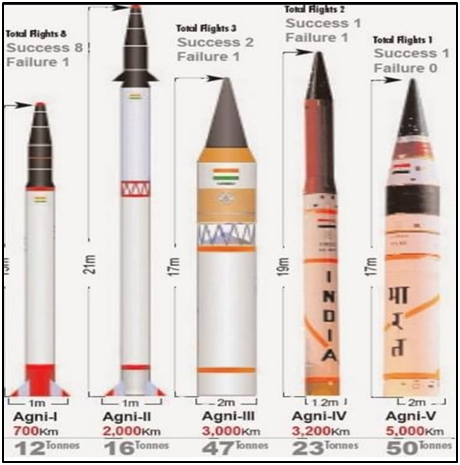
- The family consists of short to long range surface to surface ballistic missiles. These are
- Agni I – short-range ballistic missile (range – 700 to 1200 km)
- Agni II – medium-range ballistic missile (range – 2000 to 3500 Km)
- Agni III – intermediate-range ballistic missile (range – 3000 to 5000 Km)
- Agni IV – intermediate-range ballistic missile (range – 3500 to 4000 Km)
- Agni V – Inter-continental ballistic missile (range -5500 to 8000 Km)
Agni-5 missiles
- Agni is a long-range missile developed indigenously by DRDO.
- This latest variant of the missile is equipped with what is known as MIRV (Multiple Independently Targetable Re-entry Vehicle) technology.
- This Agni, capable of carrying nuclear warheads, has a range of more than 5,000 km, making it a long-range missile.
- India announced the development of Agni V in 2007.
- The maiden flight test of Agni-V was conducted in April 2012.
- Agni-V uses a three-stage solid fuelled engine and can reach most parts of China. It is aimed mainly at thwarting the challenge from China.

